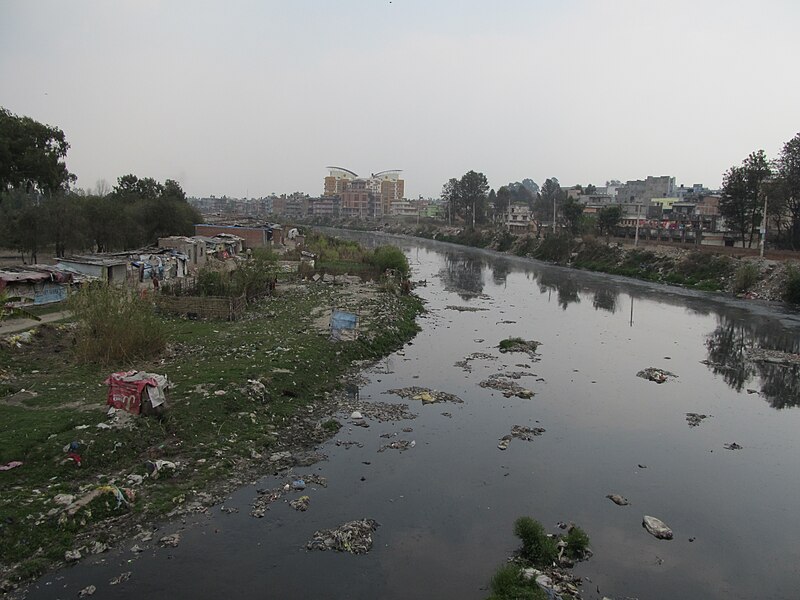Kathmandu’s Rivers Under Pressure

Data from the 2011 census shows that Nepal’s Kathmandu capital district recorded an almost 61% growth in population. In the absence of any proper planning and policies for the sustainable distribution of resources, this huge jump in demographics has put a further strain on natural resources such as the valley’s rivers.
Once the sparkling lifeblood of the fertile Kathmandu valley, the rivers have now become filthy degraded vestiges of their former selves under the impact not just of population growth but unchecked pollution and waste disposal and illegal sand mining as well.
Overflowing Garbage Bins
According to IRIN News, Kathmandu’s waste water management system is horribly inadequate.
“There is currently one fully operational central wastewater treatment plant in Kathmandu, a city of an estimated one million.
Only 12 percent of Nepal’s urban households nationwide have access to sewerage networks – with most pipelines draining directly into a river or one of several non-functioning plants – and only 5 percent of wastewater is properly treated, according to the Kathmandu office of UK-based NGO WaterAid.”
With 95% of waste water untreated and dumped directly into rivers and streams, such shortcomings are not only an enviromental crime, but pose a major public health risk. Solid waste also finds its way into the rivers because large amounts of garbage are disposed of, untreated and unchecked, along the river banks, as this picture shows.

The heavily polluted Bagmati River as seen from the Kathmandu-Lalitpur-Bridge. The informal settlement to the right is scheduled for removal. Wikimedia Commons CC BY-SA 3.0
Not Learning From History
Kathmandu’s population started to grow in the mid 1980s and growth accelerated during the Maoist insurgency (1996-2006). Following the peace agreement between the Maoists and the then government of Nepal, pressure on the capital’s region was expected to ease gradually but economic realities further fuelled the population boom.
Kathmandu’s environment was the first to suffer and the last to be compensated for all the injustice done to it. In a cover story for Himal Magazine (May 1987) entitled The Valley Chokes: Pollution in Kathmandu, Prakash Khanal reported that the valley’s air was heavy with smoke while its rivers were being used as trash cans.
“Water pollution in the Valley is primarily a result of the inability of the existing rivers to carry away and dilute organic and toxic wastes. Untreated sewage is directly released into the Bagmati and its primary tributary, the Bishnumati. Solid wastes are dumped by the riverside. The ashes of the departed, and the rotting corpses of dead dogs, and the waste of slaughter houses all meet and mingle in the river. “
Twenty five years since that report, nothing much has changed for Kathmandu’s rivers. Lot of programs were launched by the government and various organizations to clean up and preserve rivers and streams, but their results are mixed and leave much to be desired.
The private sector – including various environmental organizations and local action groups – are doing a better job of creating awareness about the rivers and protecting them. Nepal’s oldest hospital-Bir Hospital located in heart of Kathmandu, is a pioneer in medical waste management. In a city where hazardous medical waste such as infected syringes and mercury from thermometers, is casually disposed of on river banks and in ordinary trash bins, the pioneering leadership shown by Bir Hospital is indeed a positive step forward.
Neglected Gold Mines
The Kathmandu valley suffers from a severe shortage of drinking water. Every year thousands of families are forced to buy water to supplement their own meager supplies and during the summer months the situation is even worse. Haphazard ground water harvesting is also a growing problem which could also seriously affect the stability of buildings. According to eKantipur,
“Experts are warning that more than 80 percent of the groundwater used for drinking purposes in Kathmandu contains high levels of bacteria and other harmful microbes. The depletion of the groundwater level is alarming. Earlier, digging down till 20 feet was enough to strike groundwater. Now, it’s hard to strike water even at a depth of 40 feet, say experts.”
Rivers such as the Bagmati and Bishnumati could provide long-term solutions to the problem, if they are properly cared for and managed.
River management is not all about trash clean-ups. Illegal sand mining has also compromised river flow and caused stagnation, and, coupled with garbage dumping, has turned the rivers into open sewers. Powerful and well connected sand barons are adept in standing in the way of any meaningful reform or policing measure.
Time To Act Now
The time to act to save Kathmandu’s rivers is now! The government and the private sector need to come together and treat this as an urgent priority because if these rivers are not saved, Kathmandu’s thirst problem will soon run out of options.
Tags: ecology, kathmandu, kathmandu rivers, nepal, river pollution, waste water, water
